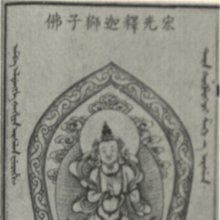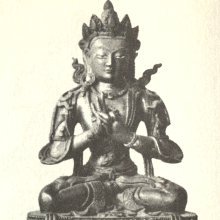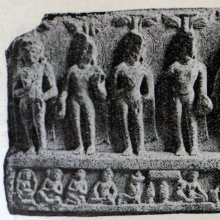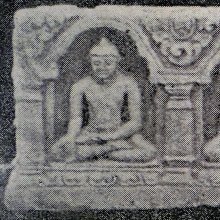Shakyasimha, Śākyasiṃha, Shakya-simha: 8 definitions
Introduction:
Shakyasimha means something in Buddhism, Pali, Hinduism, Sanskrit, the history of ancient India. If you want to know the exact meaning, history, etymology or English translation of this term then check out the descriptions on this page. Add your comment or reference to a book if you want to contribute to this summary article.
The Sanskrit term Śākyasiṃha can be transliterated into English as Sakyasimha or Shakyasimha, using the IAST transliteration scheme (?).
Images (photo gallery)
In Buddhism
Tibetan Buddhism (Vajrayana or tantric Buddhism)
Source: archive.org: The Indian Buddhist IconographyŚākyasiṃha (शाक्यसिंह) (or Gautama, Vajrāsana) refers to one of the seven mortal Buddhas (mānuṣī) whose names appear last in the list of thirty-two Buddhas in Mahāyāna Buddhism.—The last seven Tathāgatas are well-known, and are designated by the Mahāyānist as Mānuṣī or “Mortal Buddhas”. When represented, the last seven Mortal Buddhas appear all alike; they are of one colour and one form, usually sitting cross-legged,with the right hand disposed in the Bhūmisparśa-mudrā (earth-touching attitute), which is the mudrā peculiar to Akṣobhya. [...] In paintings, the Mortal Buddhas [viz., Śākhasiṃha] have usually a yellow or golden complexion. [...] Sometimes they are represented as standing, in which case the appear under a distinguishing Bodhi Tree and with a distinguishing mudrā. [...] Buddha Śākhasiṃha was conceived in another form which was called by the name of Durgatipariśodhana.
Śākhasiṃha is associated with the (Mortal) Buddhaśakti named Yaśodharā, and together they bring into existence the (Mortal) Bodhisattva named Ānanda.

Tibetan Buddhism includes schools such as Nyingma, Kadampa, Kagyu and Gelug. Their primary canon of literature is divided in two broad categories: The Kangyur, which consists of Buddha’s words, and the Tengyur, which includes commentaries from various sources. Esotericism and tantra techniques (vajrayāna) are collected indepently.
India history and geography
Source: academia.edu: The Chronological History of Tibetan BuddhismShakya-Sima (12th century BCE).—Though Buddhism was introduced in Tibet during the time of Samantabhadra (16th century BCE) but Acharya Vetalakshema [Garab Dorje] (1321-1221 BCE) was the first teacher of Tibetan Buddhism. It appears that early Tibetan Buddhists followed Indian Buddhist scholars like Shakya Simha.

The history of India traces the identification of countries, villages, towns and other regions of India, as well as mythology, zoology, royal dynasties, rulers, tribes, local festivities and traditions and regional languages. Ancient India enjoyed religious freedom and encourages the path of Dharma, a concept common to Buddhism, Hinduism, and Jainism.
Languages of India and abroad
Sanskrit dictionary
Source: DDSA: The practical Sanskrit-English dictionaryŚākyasiṃha (शाक्यसिंह).—epithets of Buddha.
Derivable forms: śākyasiṃhaḥ (शाक्यसिंहः).
Śākyasiṃha is a Sanskrit compound consisting of the terms śākya and siṃha (सिंह). See also (synonyms): śākyamuni.
Source: Cologne Digital Sanskrit Dictionaries: Edgerton Buddhist Hybrid Sanskrit DictionaryŚākyasiṃha (शाक्यसिंह).—‘lion of the Śākyas’, chiefly in verses (so all the following except Mahāvyutpatti), (1) epithet of the historic Śākya- muni (1): Mahāvyutpatti 50; Saddharmapuṇḍarīka 27.13; 28.8; 147.3 etc.; Lalitavistara 3.18; Mahāvastu ii.349.12 = iii.273.11; (2) epithet or alternative name of Śākyamuni (4): Mahāvastu iii.241.15; 244.2 (in mss.).
Source: Cologne Digital Sanskrit Dictionaries: Shabda-Sagara Sanskrit-English DictionaryŚākyasiṃha (शाक्यसिंह).—m.
(-haḥ) A name of Budd'Ha. E. śākya the name of his tribe, and siṃha chief.
Source: Cologne Digital Sanskrit Dictionaries: Monier-Williams Sanskrit-English DictionaryŚākyasiṃha (शाक्यसिंह):—[=śākya-siṃha] [from śākya] m. ‘Śakya lion’, Name of Gautama Buddha, [ib.; Rājataraṅgiṇī]
Source: Cologne Digital Sanskrit Dictionaries: Yates Sanskrit-English DictionaryŚākyasiṃha (शाक्यसिंह):—[śākya-siṃha] (haḥ) 1. m. Idem.
[Sanskrit to German]
Sanskrit, also spelled संस्कृतम् (saṃskṛtam), is an ancient language of India commonly seen as the grandmother of the Indo-European language family (even English!). Closely allied with Prakrit and Pali, Sanskrit is more exhaustive in both grammar and terms and has the most extensive collection of literature in the world, greatly surpassing its sister-languages Greek and Latin.
See also (Relevant definitions)
Partial matches: Shakya, Simha.
Full-text: Arkabandhu, Shakyapumgava, Sakyamuni, Vipashyin, Buddhism, Yashodhara, Durgatiparishodhana, Ananda, Gayakashyapa, Chandaka, Carana, Prathamacarana, Dakarnavatantra, Gautama, Dakarnava, Buddha, Manushi, Vajrasana, Shakya.
Relevant text
Search found 10 books and stories containing Shakyasimha, Śākyasiṃha, Shakya-simha, Śākya-siṃha, Sakyasimha, Sakya-simha; (plurals include: Shakyasimhas, Śākyasiṃhas, simhas, siṃhas, Sakyasimhas). You can also click to the full overview containing English textual excerpts. Below are direct links for the most relevant articles:
The Indian Buddhist Iconography (by Benoytosh Bhattachacharyya)
Figure 17 - Buddha in different Mudrās (Nalanda)
Figure 18 - Buddha in different Mudrās (Java)
Blue Annals (deb-ther sngon-po) (by George N. Roerich)
Chapter 2b - The Lineage of the mdo < [Book 3 - Early translations of Secret Mantra]
Current Topics < [May-June 1931]
Mahabharata (English) (by Kisari Mohan Ganguli)
Section CCLXXXVIII < [Mokshadharma Parva]
Complete works of Swami Abhedananda (by Swami Prajnanananda)
An Introduction to the Philosophy of Panchadasi < [Discourse 6 - An Introduction to the Philosophy of Panchadasi]
The Fo-Sho-Hing-Tsan-King (A Life of Buddha) (by Samuel Beal)
Varga 23. By Spiritual Power Fixing His (Term of) Years < [Kiouen V]
Varga 25. Parinirvāṇa < [Kiouen V]
Related products


.jpg)

